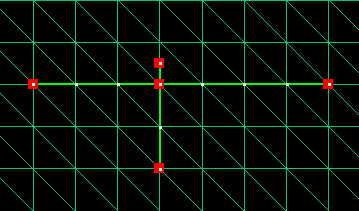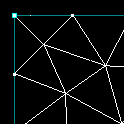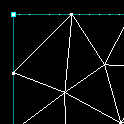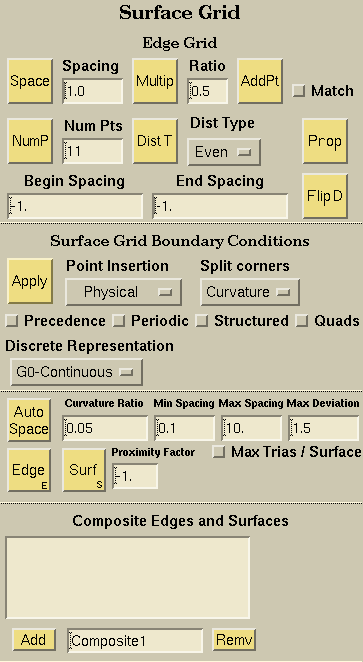
Edge Grid Generation:
Set Point Spacing
A point spacing is a physical dimension applied to vertices to control edge grid distributions. Given a set of point spacings at the vertices on an edge, a 1D Advancing Front algorithm is used to compute the number of grid points and the linear distribution along that edge. To apply point spacings, pick any number of vertices, set the desired spacing, and hit return within the Spacing field; or set the desired spacing and hit the Space button. Applying a point spacing will automatically update all edge grids attached to the vertices. Any surface grids that depend on the edge grids will automatically be flagged to be regenerated when the surface mesh is recomputed. There are 3 methods used to apply point spacings:
- Pick any number of end points. CAUTION:Make sure the pick limit is set to "Point" to ensure that the end point is picked, and not the interior of an adjacent edge.
- Pick a point in the interior of an edge. This will create a new point at the picked location. To remove the point spacing, simply delete the point. CAUTION: Do not specify an interior point spacing that is too close (within gluing tolerance) to the end point.
- Pick a point and an edge. This will create a new point at the closest distance from the point to the edge. This is useful when trying to match point spacings on edge that are close to each other but have varying locations of end points.
Point Spacing field
The value in the Spacing field specifies the absolute spacing at all selected points.Multiply Point Spacing
Multiply the point spacing by the ratio specified in the ratio field. This can be used to quickly add or remove points and maintain point spacing distributions.Multiply Point Spacing field
The Multiply Point Spacing field is used to specify the multiplier or ratio used to scale the point spacing values. Hitting the return/enter key while the cursor is in this field is equivalent to hitting the Multiply Point Spacing button.Add Point
Add a single grid point to a given edge with the same value end point spacings. This is useful for very small edges that need an additional interior point, but you do not want to compute the required end point spacings. NOTE: This function does not work unless both end point spacings have the same value.Matched Spacing toggle
The Matched spacings on/off toggle determines whether a point spacing will be altered to reflect the shortest curve arc length adjacent to the given point. If match spacings is on, any picked point spacing that is larger than the shortest adjacent curve arc length will be set to match the shortest adjacent curve arc length. This is extremely useful when generating initial grids for very complex geometries.For structured edges, the point spacing value is set to the the minimum spacing value of the adjacent structured edges.
This is an example of when the Matched spacings on/off toggle is "off." As you can see, the spacing of the tiny white edge grid points is larger than the smallest spacing between two of the picked points.
If the Matched spacings on/off toggle is turned "on," the result would look like this. The new point spacing will match the spacing between the two picked points which are closest to each other, if that distance is shorter than the assigned point spacing.
Set Number of Points on an Edge
Sets the edge grid resolution specified in the Number of Points on an Edge field to the selected edges. The Number of Points button calculates the required spacing at the edge vertices, based on arclength, to insert this desired number of points. The required spacing is then applied to the end points, and the points are inserted.For structured edges, the number of points are automatically propogated to opposite structured edge on adjacent structured faces.
Number of Points on an Edge field
The Number of Points on an Edge field is used to specify the number of points or edge grid resolution along an edge. Hitting the return/enter key while the cursor is in this field is equivalent to hitting the Number of Points in an Edge button.Structured Edge Grid Generation:
Edges that are part of a surface marked with Structured boundary condition are denoted structured edges. As opposed to traditional unstructured edge grids where the number of points along the edge varies with the point spacing value, the number of points on structured edges are held constant.
Apply Edge Spacing Distribution
Edge Spacing Distribution Methods
Even Uniform edge grid distribution (Default value). Points are equally spaced along the edge.
TanH Hyperbolic tangent edge grid distribution. The hyperbolic tangent distribution function is used to set a fixed point spacing at one or both ends of the edge, and distribute the remaining points such that the edge grid grows or shrinks by a hyperbolic tangent function. The fixed point spacing is set using the Beginning and Ending Point Spacing values. A value of zero applies a natural condition with an unspecified end condition allowing the function to naturally dissipate.
SinH Hyperbolic sine edge grid distribution. The hyperbolic sine distribution function is used to set a fixed point spacing at the beginning of the edge and distribute the remaining points such that the edge grid grows or shrinks by a hyperbolic sine function.
Geom A geometric edge grid distribution. The geometric distribution function is used to set a fixed point spacing at one or both ends of the edge, and distribute the remaining points such that the edge grid grows or shrinks by a geometric (Blasius) function where a thin layer approximation is used to determine the stretching. The fixed point spacing is set using the Beginning and Ending Point Spacing values. A value of zero applies a natural condition with an unspecified end condition allowing the function to naturally dissipate.Propogate Picked Edge
Recursively pick the opposite structured edge on adjacent structured faces.Set Beginning Point Spacing
A negative value implies that the beginning point spacing is derived from the attached vertex. The absolute value is used as a scale factor. A positive value denotes an absolute point spacing at the beginning of the edge. If the specified value is smaller than the point spacing of the attached vertex, the point spacing is set to the beginning value.Set Ending Point Spacing
A negative value implies that the ending point spacing is derived from the attached vertex. The absolute value is used as a scale factor. A positive value denotes an absolute point spacing at the ending of the edge. If the specified value is smaller than the point spacing of the attached vertex, the point spacing is set to the ending value.Reverse Edge Spacing Distribution
Reverses the edge grid distribution on the selected edges by flipping the Beginning and Ending Point Spacing values.Generate Edge Grid
To draw edge grids for all visible surfaces, you only have one thing to do: select the Edge button. If any edge grids have not been initialized (or had their point spacings set) then a resolution of 11 points will be used.Generate Edge Grid
Automatically sets point spacings to existing nodes that are visible and, if necessary, inserts point spacing sources on the interior of visible edges. These point spacing values for the visbile vertices can be altered as needed before grid generation. The point spacing sources that are inserted into edges can be altered and deleted, if necessary, before grid generation.Set Minimum Point Spacing Value
This is the lower limit of point spacing used by this feature. No point spacings affected by this feature will fall below this value. This value is not a ratio, it is an absolute value.Set Maximum Point Spacing Value
This is the upper limit of point spacing used by this feature. No point spacings affected by this feature will exceed this value. This value is not a ratio, it is an absolute value.Set Curvature Ratio
This field sets the value for Curvature Ratio which a parameter used to automatically apply end-point spacings based on curvature. Below is a figure to aid in defining this parameter.Consider the figure above. This curve needs to have point spacings applied to the ends. In order to do this automatically, the a "test point" is inserted in the middle.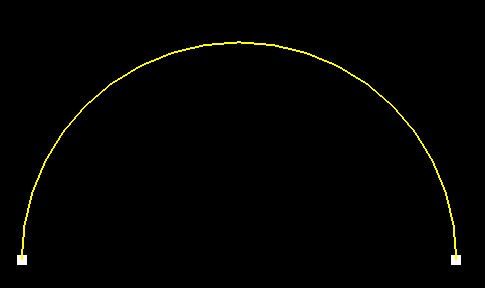 A ratio is formed from the distance between the "test point" (red point on curve) and a straight line between the two end points. If this ratio is above the value in the Curvature Ratio field, then the curve needs a smaller point spacing value on the end. This process is repeated with the two new intervals formed by the two end-points and the newly inserted point until none of the intervals violate the value in the Curvature Ratio field. This grid is the ideal edge grid. The end-point spacing is then set using the ideal edge grid. The applied point spacing will not fall below the Minimum Point Spacing and it will not exceed the Maximum Point Spacing. In general, a lower value will increase the end-point spacings in the model and a higher value will decrease the end-point spacings in the model.
A ratio is formed from the distance between the "test point" (red point on curve) and a straight line between the two end points. If this ratio is above the value in the Curvature Ratio field, then the curve needs a smaller point spacing value on the end. This process is repeated with the two new intervals formed by the two end-points and the newly inserted point until none of the intervals violate the value in the Curvature Ratio field. This grid is the ideal edge grid. The end-point spacing is then set using the ideal edge grid. The applied point spacing will not fall below the Minimum Point Spacing and it will not exceed the Maximum Point Spacing. In general, a lower value will increase the end-point spacings in the model and a higher value will decrease the end-point spacings in the model.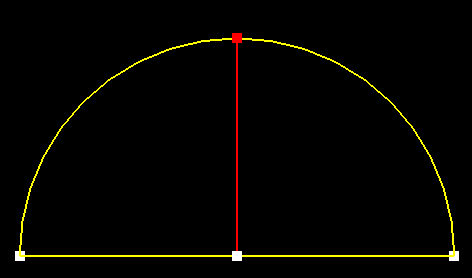
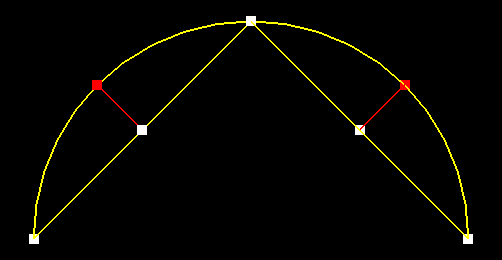
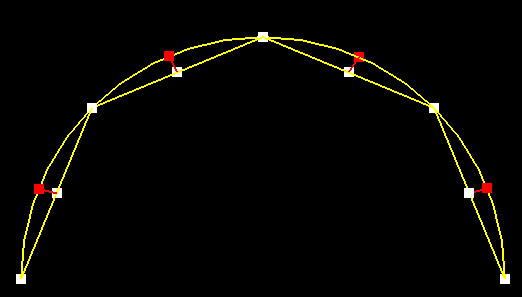
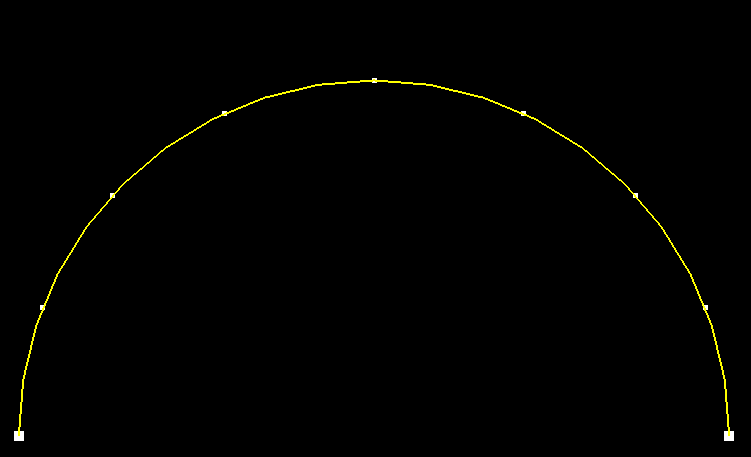
Set Maximum Deviation
After the end-point spacing is set by the Curvature Ratio, the resulting edge grid seen in the above figure is analyzed. At each interior point, the current point spacing is compared to the ideal point spacing. The value in the Max Deviation field is used as a threshold factor for how much the current interior point spacing can deviate from the ideal interior point spacing at that location. If the deviation is more than the value in the Max Deviation field, a point spacing source is placed with the appropriate value to increase point spacing. The point spacing sources will not fall below the Minimum Point Spacing and it will not exceed the Maximum Point Spacing. In general, a lower value will increase the number of interior point spacing sources in the model and a higher value will decrease the number of interior point spacing sources in the model. This value should not be lower than 1.Proximity Factor Value
The value in this field sets the Proximity Factor. This value is ignored if it left with a negative sign. The Proximity Factor is used to further refine edge grids based on their proximity to each other. The local grid spacing is multiplied by this factor and then a search is performed to determine if any edge grids are within this "distance." If an edge grid is found within this "distance" then the edge grid is refined locally, via point-spacing sources, in order to satisfy the user-defined Proximity Value. The point spacing sources will not fall below the Minimum Point Spacing and it will not exceed the Maximum Point Spacing.
Surface Grid Boundary Conditions:
Point Insertion Method
Physical Generate surface grid points using a combination of the Mapped Surface Approximation (MSA) and Physical Space Approximation (PSA) algorithms. This provides high quality grids that lay on the original surface.
UV Generate surface grid points using the Mapped Surface Approximation (MSA) algorithm. This will generate surface grids in the parametric space of the underlying surface, and it is affected by parametric stretching.
Approximate Generate surface grid points using a combination of the Mapped Surface Approximation (MSA) and Physical Space Approximation (PSA) algorithms. The grid points generated by the PSA algorithm are used directly, and the last evaluations to the original surface are omitted.Split Corners
The split corners selector tells the surface grid generation routine how to split (or not to split) corner elements. A corner element is any element that has at least two edges connected to the boundary. There are three types of corner splitting available:
Curvature splitting uses the curvature of the
surface in determining whether or not to split a corner.Force splitting always splits corner elements. No splitting turns this feature off. Precedence Surface toggle
This toggle specifies that the edge grid that bounds the selected surface will lie on that surface. This is particularly important on a rebuild surface that intersects a viscous or normal growth surface. Even though the surfaces are within geometric tolerance, there may be variations in the rebuild surface grid that are greater than the solver can tolerate.NOTE: Precedence should always be applied to a rebuild surface.
Periodic Surface toggle
Create identical periodic grids on two topologically and geometrically similar surfaces. To specify a pair of periodic surfaces, pick two surfaces, a geometrically similar point on each surface, and optionally a reference axis (i.e. an axis of rotation). If the reference axis is not specified, it will be determined automatically. Otherwise, the specified vector will be used. To apply, select the Periodic toggle and click the Apply button. During surface grid generation, a surface grid will be calculated for one of the surfaces and then a copy of the calculated surface grid will be transformed to the other surface. The transformation between the two surfaces is automatically determined.To remove the periodic boundary condition, simply select either one of the periodic surfaces, deselect the Periodic toggle, and click the Apply button. The periodic boundary condition will automatically be removed if either of the surfaces is modified topologically or geometrically.
The periodic boundary condition may NOT be combined with the Structured surface grid boundary condition.
Periodic boundary condition informaion can not be saved to an IGES file since not all the necessary information can be saved to reapply the boundary condition.
Structured Surface Grid toggle
Generate a structured surface grid on the selected faces. Structured surface grids can be generated on any face. If the face was created from a Plot3D formatted surface, then the underlying surface parameterization is used to generate the structured surface grid. If the Quads Surface Grid boundary condition is applied, then quadrilaterals will be generated; otherwise right triangles will be generated. For an arbitrary geometric surface, the quadrilateral surface grid will be generated using an algebraic structured surface mesh algorithm. Various distribution functions can be applied to control the edge grid distribution. Note that the face must be four-sided. To generate a structured surface grid on an n-sided trimmed face or composite face, use composite edges to define the four sides.The structured boundary condition may NOT be combined with the Periodic surface grid boundary condition.
Quads Surface Grid toggle
Generate a structured quad mesh on the surface. This feature works only with the Structured Surface Grid boundary condition.Discrete Surface Evaluation chooser
The Discrete Surface chooser allows the user to select how the grid points are evaluated during the surface grid generation. Note that this applies only to discrete geometry surfaces.
- G0-Continuous uses linear interpolation
- G1-Continuous uses higher-order interpolation
Apply surface grid conditions
Applies surface grid conditions to all picked surfaces.
Surface Grid Generation:
Generate surface grid
To generate the surface grid for all visible faces, you must first put all faces in groups, if you have not already done so. You may then select the Surface button to generate the surface grid. Surface grids will only be recalculated on surfaces whose edge grids have changed or whose geometry has been manipulated.The edge grid evaluation may be determined from either of the two adjacent faces. The priority is determined as follows:
- Periodic faces with the Rebuild volume grid generation boundary condition
- Periodic faces
- Precedence faces with the Rebuild volume grid generation boundary condition
- Precedence surfaces
- Surfaces with the Rebuild volume grid generation boundary condition
- Remaining faces
Composite Topology Creation and Management
Create and manage composite edges and surfaces. A composite edge is a collection of edges that, for grid generation purposes, are treated as a single topological edge. The individual edges, or component edges, that define the composite edge must be topologically adjacent. In addition, vertices on the interior of the composite edge definition must be adjacent to exactly two edges. Discrete geometry, CAPRI edges, and trimming curves may be used in a composite edge. Physical curves cannot be used in a composite edge definition. Note that vertices on the interior of the composite edge definition are no longer visible once the composite is created. Composite edges can be used with trimmed surfaces or composite faces to define a four-sided face for use with the structured surface grid generation algorithm.Similarly, a composite face is a collection of faces that, for grid generation purposes, are treated as a single topological face. The individual faces, or component faces, that make up the composite face must be topologically adjacent. Discrete geometry, CAPRI surfaces, and CAD surfaces may be used in a composite face. Note that edges and vertices on the interior of the composite face definition are no longer visible. The surface grid points for the resulting composite surface grid lie on the original geometric face.
Composite edges and faces are particularly useful for improving surface grid quality. In situations where very small edges restricts the grid size, small edges can be combined with adjacent edges to create a longer composite edge that results in a more uniform distribution and better surface grid quality. Similarly for composite faces, small or sliver faces can be combined with adjacent faces to create a larger composite face which results in better surface grid quality.
Add Edge or Face to Composite Definition
To create a composite edge or face, select the desired edges or faces and click the Add button. A new composite edge or surface is created with the name specified in the field to the right of the button. To add an edge or face to an existing composite entity, select the desired composite from the Composite List Editor and click Add. Note that an edge or face may be included in only one composite definition. If an edge or face is already included in a composite definition, it will be removed from the original composite definition and added to the selected composite definition.Remove Edge or Face from Composite Definition
To remove an edge or face from a composite definition, simply select the edge or face and click Remv. To delete a composite definition, select the composite in the Composite List Editor and click Remv.
